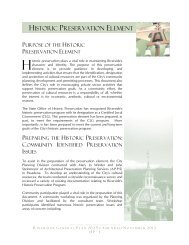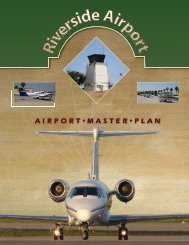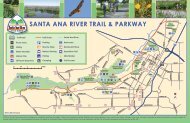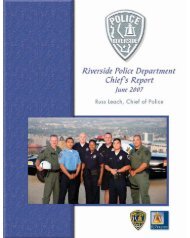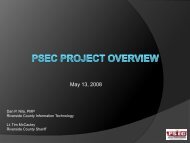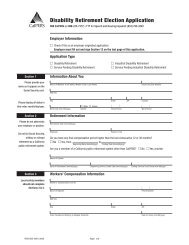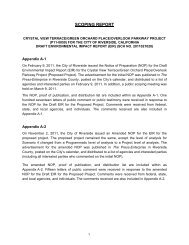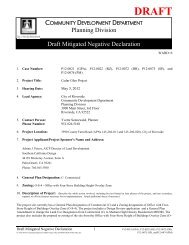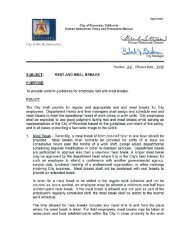Northside - City of Riverside
Northside - City of Riverside
Northside - City of Riverside
Create successful ePaper yourself
Turn your PDF publications into a flip-book with our unique Google optimized e-Paper software.
The Spanish-speaking community was unique in the Rancho period, which was<br />
characterized by livestock ranching rather than farming and did not promote<br />
individual land and home ownership. The independent landholders <strong>of</strong> La Placita<br />
and Agua Mansa owned their own adobe homes and farms, which were irrigated by<br />
ditches dug from the Santa Ana River. They grew both gain and garden produce<br />
such as grapes and raised animals for meat, milk, and labor. By 1855, the community<br />
boasted about 200 members and eventually had more than 100 little farming fields<br />
(Patterson 1996:127-8), and their horses, sheep, and cattle freely grazed on<br />
government land and what would become <strong>Riverside</strong>, causing quick and lasting<br />
conflict with <strong>Riverside</strong>rs until the early 20 th century.<br />
The lands within the survey area were also part <strong>of</strong> Bandini’s Rancho Jurupa and<br />
were purchased by the California Silk Center Association in 1868. In September<br />
1870, the Southern California Colony Association, led by John W. North, purchased<br />
the holdings <strong>of</strong> the California Silk Center Association, which consisted <strong>of</strong><br />
approximately 8,600 acres <strong>of</strong> the eastern portion <strong>of</strong> the Rancho, and founded the<br />
colony <strong>of</strong> <strong>Riverside</strong>. The short-lived silkworm colony had been founded in 1868 by<br />
Louis Prevost, a native <strong>of</strong> France, and his death in early 1870 caused the<br />
abandonment <strong>of</strong> the project by co-investors just before the state <strong>of</strong> California<br />
withdrew the high, promotional bounties it had been <strong>of</strong>fering for the planting <strong>of</strong><br />
mulberry trees and silkworm cocoons (Patterson 1996:35). Almost immediately after<br />
purchasing the silk colony lands, work on an irrigation canal began under the<br />
direction <strong>of</strong> a former silk colony director, Thomas Cover, who was one <strong>of</strong> four men<br />
to join the new colony. By the end <strong>of</strong> the same year, the holdings <strong>of</strong> the Southern<br />
California Colony Association were surveyed and platted by Goldsworthy and<br />
Higbie as an orthogonal plan with 10-acre parcels to the north and south <strong>of</strong> a onemile<br />
square townsite known as the Mile Square (plat map 1870). The Mile Square<br />
lies to the northeast within the current city boundaries, and the survey area is<br />
located wholly within the 10-acre parcels to the north. The orthogonal street plan,<br />
which is oriented on a northeast/southwest axis, rather than strictly following the<br />
cardinal points, corresponded with the boundary lines <strong>of</strong> the Spanish rancherías that<br />
once defined land ownership in the region and continues to the <strong>Riverside</strong>-San<br />
Bernardino County boundary.<br />
Also in 1870, a nearly 13-square-mile area to the southwest, which included much <strong>of</strong><br />
the government land, was purchased by Benjamin Hartshorn. Part <strong>of</strong> the Hartshorn<br />
Tract, which was also laid out in the orthogonal pattern, was sold in 1874 to investor<br />
William T. Sayward and Indiana banker Samuel C. Evans who soon established the<br />
<strong>Riverside</strong> Land and Irrigating Company. The area became known as Arlington, a<br />
distinct community (Bynon 1893-4:21). Between the lands owned by the Southern<br />
California Colony Association and the <strong>Riverside</strong> Land and Irrigating Company<br />
remained a much-reduced, mile-wide strip <strong>of</strong> land known as the Government Tract,<br />
where streets were laid out on a strict north-south grid and intersect at odd angels<br />
22



